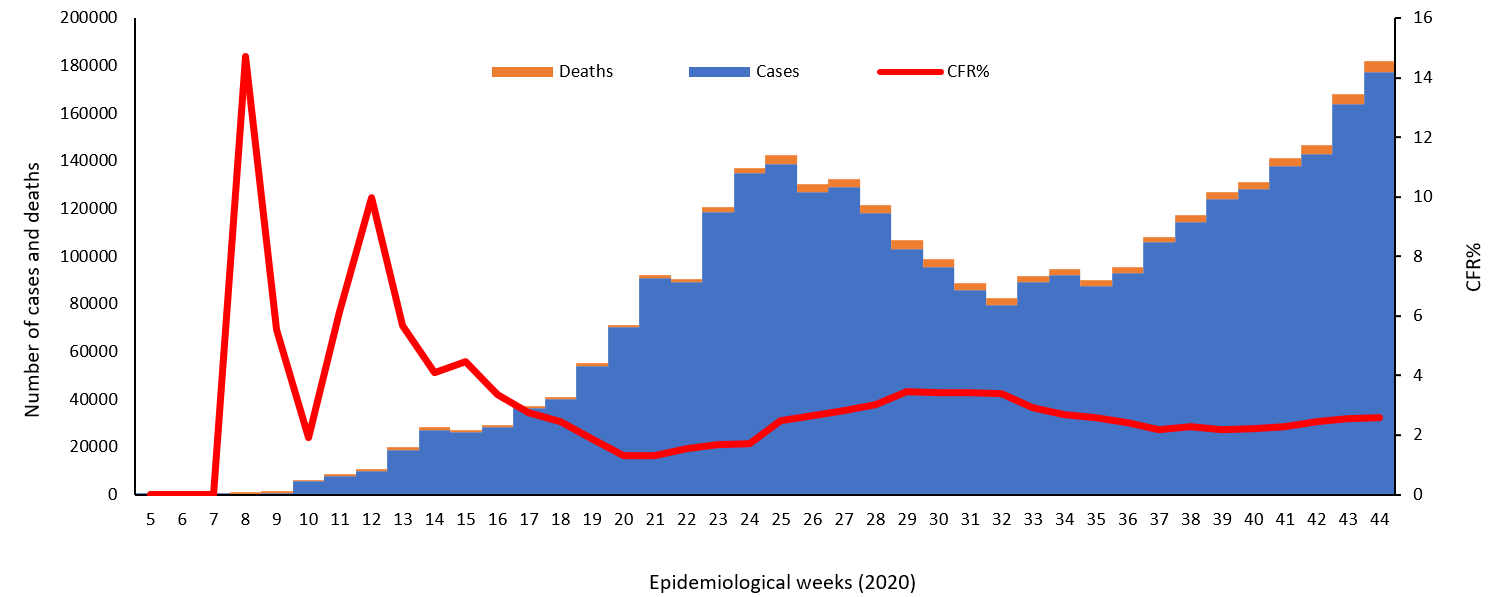The coronavirus disease COVID-19 continues to spread at the regional and global levels. As of 31 October 2020, the global cumulative incidence reached 45 428 731 reported cases and 1 185 721 associated deaths with a case fatality ratio (CFR) of 2.6%. Meanwhile, the 22 countries of the Eastern Mediterranean Region (EMR) have reported a total of 3 092 037 cases, which represent about 6.8% of the global count, with 78 599 associated deaths (CFR 2.5%). Most countries in the Region are in the community transmission phase.
Since the beginning of the outbreak, the country that has reported the highest number of total cases in the Region is Islamic Republic of Iran (612 772 cases; 19.8% of the Region’s total), followed by Iraq (472 630; 15.3%) and Saudi Arabia (347 282; 11.2%). Islamic Republic of Iran also reported the highest number of total associated deaths (34 864; CFR 5.7%) followed by Iraq (10 910; CFR 2.3%) and Pakistan (6806; CFR 2%). The highest CFRs were reported by Yemen (29%) followed by Sudan (6.1%), while the lowest CFRs were reported by Qatar (0.2%) followed by Bahrain and United Arab Emirates (0.4% each).
During epidemiological week 44, the Region reported an 8.1% increase in cases when compared to the previous week (177 234 cases compared to 163 943 cases). Similarly, a 9.8% increase was observed for associated deaths (4570 deaths compared to 3508 deaths). The weekly trend per capita showed a slight increase as compared to the previous week (423/100 000 compared to 398/100 000).
Jordan, Lebanon and Tunisia reported a relative increase in COVID-19 activity. The cumulative number of cases in Jordan increased from 50 750 to 72 607 (43% increase compared to the previous weeks), Lebanon from 69 990 to 81 228 (16% increase) and Tunisia from 52 399 to 59 813 (14% increase). Jordan had the largest relative increase in deaths (54%) followed by Tunisia (34%), Lebanon and Morocco (11% each).
In terms of testing, a total of 46 526 542 laboratory PCR tests were conducted since the start of the outbreak across the Region including 2 405 021 tests in week 44, which shows a 2% increase compared to the previous week (2 357 713). The highest number of PCR tests were reported from United Arab Emirates (13.2 million), followed by Saudi Arabia (8.1 million) and Islamic Republic of Iran (4.9 million). The United Arab Emirates and Bahrain are performing the highest rate of testing per capita (133 303/100 000 and 102 838/100 000, respectively). The average positivity rate for the Region is 6.6%. WHO recommends a positivity rate of around 3–12% as a general benchmark indicating adequate testing, which was achieved in most countries of the Region.
Supporting countries in the Region
The regional incident management support team continues to coordinate the response and provide technical support to countries and partners in the Region in the areas of coordination and partnership, surveillance, laboratory capacity, clinical management, infection prevention and control, risk communication and community engagement, points of entry according to the International Health Regulations (2005), research, health systems, and essential health services among others. Activities this week included:
holding the 14th webinar of COVID-19 laboratory community of practice on 28 October, which focused on performance and contexts of use of SARS-CoV-2 antigen rapid diagnostic tests, access to tests and biosafety considerations;
organizing in Morocco the national workshop on integration of sexual and reproductive health into policies, programmes and practices, and the adoption of WHO tools and guidance for its integration; and
launching of the COVID-19 clinical management course through the OpenWHO online platform.

For more data from the Region, please visit the COVID-19 dashboard.
Subscribe to the monthly infectious hazard preparedness newsletter of WHO’s Health Emergencies Programme for latest data and analysis on epidemic- and pandemic-prone diseases, as well as news on outbreak preparedness and response within WHO’s Eastern Mediterranean Region.




